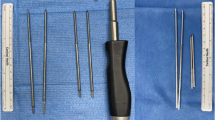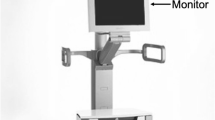Abstract
The use of computer-navigated, robotic-assisted total knee arthroplasty (TKA) is expanding as the result of widespread efforts to improve the precision of implant placement and to restore mechanical, anatomic, and kinematic alignment. The procedure requires placement of femoral and tibial pins to mount the robotic tracking system. Fractures through tracking pin sites following robotic-assisted TKA are rare; only 30 cases have been reported to our knowledge. It is probable that this complication will become more frequent as the use of robotic-assisted TKAs continues to grow. We report the case of a 67-year-old female who suffered a fracture of the femur through two pin sites 3 months after a robotic-assisted TKA. We believe that this report is the first case in the radiologic literature. Our case demonstrates some of the difficulties of recognizing this complication and raises questions about appropriate post-operative imaging.






Similar content being viewed by others
References
Bendich I, Kapadia M, Alpaugh K, Diane A, Vigdorchik J, Westrich G. Trends of utilization and 90-day complication rates for computer-assisted navigation and robotic assistance for total knee arthroplasty in the United States from 2010 to 2018. Arthroplast Today. 2021;11:134–9.
de Steiger RN, Liu YL, Graves SE. Computer navigation for total knee arthroplasty reduces revision rate for patients less than sixty-five years of age. J Bone Joint Surg Am. 2015;97:635–42.
Chin BZ, Tan SSH, Chua KCX, Budiono GR, Syn NL, O’Neill GK. Robot-Assisted versus conventional total and unicompartmental knee arthroplasty: a meta-analysis of radiological and functional outcomes. J Knee Surg. 2021;34:1064–75.
Hetaimish BM, Khan MM, Simunovic N, Al-Harbi HH, Bhandari M, Zalzal PK. Meta-analysis of navigation vs conventional total knee arthroplasty. J Arthroplasty. 2012;27:1177–82.
Kim YH, Yoon SH, Park JW. Does robotic-assisted TKA result in better outcome scores or long-term survivorship than conventional TKA? A randomized, controlled trial. Clin Orthop Relat Res. 2020;478:266–75.
Matziolis G, Krocker D, Weiss U, Tohtz S, Perka C. A prospective, randomized study of computer-assisted and conventional total knee arthroplasty. Three-dimensional evaluation of implant alignment and rotation. J Bone Joint Surg Am. 2007;89:236–243.
Yang HY, Seon JK, Shin YJ, Lim HA, Song EK. Robotic total knee arthroplasty with a cruciate-retaining implant: a 10-year follow-up study. Clin Orthop Surg. 2017;9:169–76.
Kamara E, Robinson J, Bas MA, Rodriguez JA, Hepinstall MS. Adoption of Robotic vs fluoroscopic guidance in total hip arthroplasty: is acetabular positioning improved in the learning curve? J Arthroplasty. 2017;32:125–30.
Marchand KB, Ehiorobo J, Mathew KK, Marchand RC, Mont MA. Learning Curve of robotic-assisted total knee arthroplasty for a high-volume surgeon. J Knee Surg. 2020.
Skibicki HE, Ponzio DY, Brustein JA, Post ZD, Ong AC, Orozco FR. A cautionary case: osteoporotic femur fracture after robotic-assisted total knee arthroplasty. Osteoporos Int. 2021;32:2125–9.
Smith TJ, Siddiqi A, Forte SA, Judice A, Sculco PK, Vigdorchik JM, Schwarzkopf R, Springer BD. Periprosthetic fractures through tracking pin sites following computer navigated and robotic total and unicompartmental knee arthroplasty: a systematic review. JBJS Rev. 2021;9:e20.00091.
Yun AG, Qutami M, Pasko KBD. Do bicortical diaphyseal array pins create the risk of periprosthetic fracture in robotic-assisted knee arthroplasties? Arthroplasty. 2021;3:25.
Gregory P, Pevny T, Teague D. Early complications with external fixation of pediatric femoral shaft fractures. J Orthop Trauma. 1996;10:191–8.
Owens RF Jr, Swank ML. Low incidence of postoperative complications due to pin placement in computer-navigated total knee arthroplasty. J Arthroplasty. 2010;25:1096–8.
Blue M, Douthit C, Dennison J, Caroom C, Jenkins M. Periprosthetic fracture through a unicortical tracking pin site after computer navigated total knee replacement. Case Rep Orthop. 2018;2018:2381406.
Marshall RA, Mandell JC, Weaver MJ, Ferrone M, Sodickson A, Khurana B. Imaging features and management of stress, atypical, and pathologic fractures. Radiographics. 2018;38:2173–92.
Ardran GM. Bone destruction not demonstrable by radiography. Br J Radiol. 1951;24:107–9.
Urish KL, Qin Y, Li BY, Borza T, Sessine M, Kirk P, Hollenbeck BK, Helm JE, Lavieri MS, Skolarus TA, Jacobs BL. Predictors and cost of readmission in total knee arthroplasty. J Arthroplasty. 2018;33:2759–63.
Author information
Authors and Affiliations
Corresponding author
Ethics declarations
Conflict of interest
The authors declare no competing interests.
Additional information
Publisher's note
Springer Nature remains neutral with regard to jurisdictional claims in published maps and institutional affiliations.
This work was performed at Massachusetts General Hospital, Boston, MA, USA.
Rights and permissions
About this article
Cite this article
Feroe, A.G., Chakraborty, A.K., Rosenthal, D.I. et al. Fracture through tracking pin sites following a robotic-assisted total knee arthroplasty. Skeletal Radiol 51, 2217–2221 (2022). https://doi.org/10.1007/s00256-022-04034-4
Received:
Revised:
Accepted:
Published:
Issue Date:
DOI: https://doi.org/10.1007/s00256-022-04034-4




